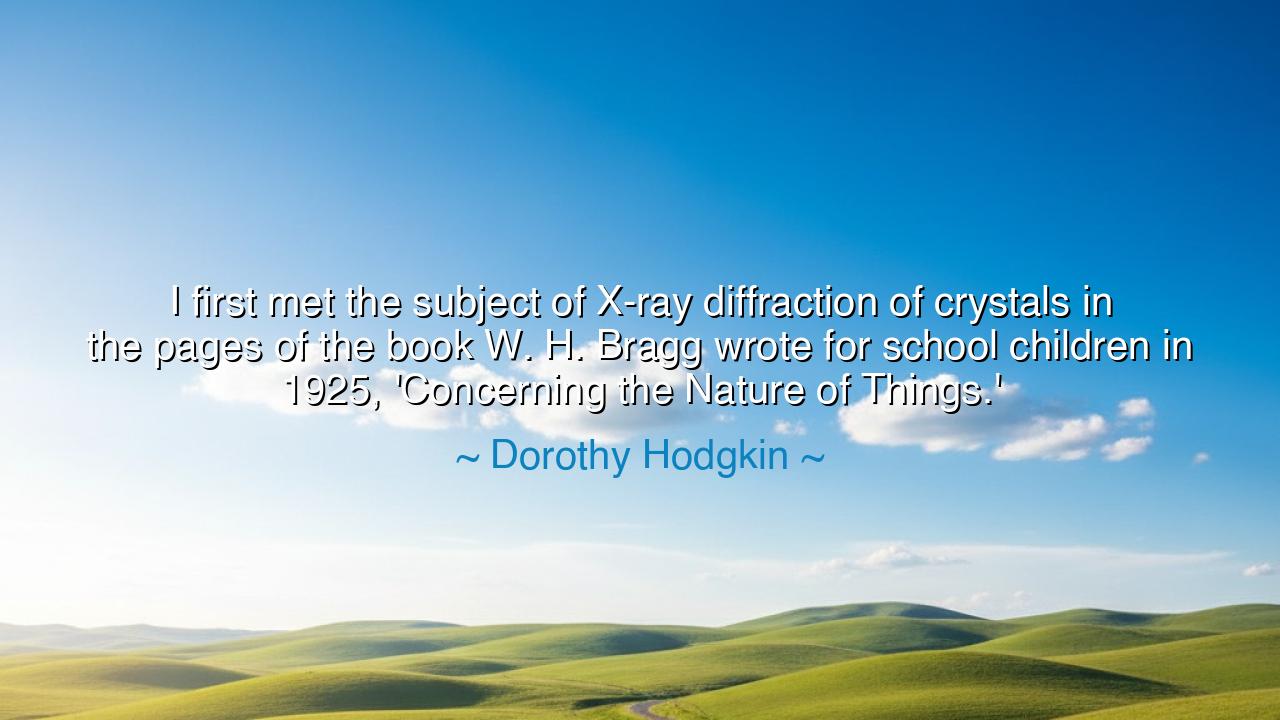
I first met the subject of X-ray diffraction of crystals in the
I first met the subject of X-ray diffraction of crystals in the pages of the book W. H. Bragg wrote for school children in 1925, 'Concerning the Nature of Things.'






In the quiet yet powerful words of Dorothy Hodgkin, Nobel laureate and pioneer of chemistry, we hear the story of destiny awakened: “I first met the subject of X-ray diffraction of crystals in the pages of the book W. H. Bragg wrote for school children in 1925, Concerning the Nature of Things.” This is not simply the memory of a scientist recalling her youth; it is the testimony of how a single encounter with knowledge can alter the course of a life, turning a curious child into a seeker of truth, and a seeker into one of the great discoverers of her age.
To say she “first met” the subject is to speak of science not as dry fact, but as a living being—something encountered, embraced, and befriended. In the pages of Bragg’s book, Hodgkin did not merely see diagrams and explanations; she saw a doorway into the invisible world of crystals, where order and mystery combined in patterns beyond the reach of ordinary sight. What was written for children became, in her eyes, a sacred invitation, and she accepted it with the zeal of one whose heart was already tuned to wonder.
The book itself was the work of W. H. Bragg, who along with his son, W. L. Bragg, had unlocked the secrets of crystal structure through X-ray diffraction, a discovery that earned them the Nobel Prize in 1915. Yet Bragg chose not only to publish for scholars but also to speak to children, distilling the mysteries of the universe into words simple and clear. In this act, he sowed seeds far beyond his imagining. One of those seeds took root in Hodgkin, and from it grew a life dedicated to unveiling the structures of insulin, penicillin, and vitamin B12—discoveries that changed medicine and saved lives. Thus, in her quote, we see the living lineage of knowledge, passed like a torch from one mind to another across the generations.
Consider how many lives have been changed by such encounters. When Michael Faraday, the bookbinder’s apprentice, stumbled upon a volume of lectures on electricity, his imagination was ignited, and he rose to become one of the greatest experimental scientists of all time. When Marie Curie found herself in a humble laboratory, she saw not dust and glassware but the possibility of uncovering forces hidden in matter itself. So too, Hodgkin’s chance meeting with Bragg’s book became the spark of a lifelong devotion to science. History is filled with these stories: the right book, the right teacher, the right moment, and a destiny forever altered.
The meaning here is both simple and profound: greatness often begins in the smallest encounters. A single sentence, a book read in youth, a word of encouragement from a teacher—these can shape the direction of an entire life. Hodgkin reminds us that inspiration does not always come in grand revelations, but in the quiet turning of pages, where knowledge waits patiently for the one ready to receive it. The seeds of tomorrow’s discoveries lie hidden in today’s acts of teaching, writing, and sharing.
From her story, a lesson shines forth: never underestimate the power of knowledge offered with simplicity. Those who write for children, who teach with clarity, who share wisdom humbly, may ignite the fires of genius in minds yet unformed. And for the young, the lesson is this: read widely, listen deeply, and be attentive, for you do not know which page, which word, which subject will awaken your true calling.
Thus, Dorothy Hodgkin’s remembrance becomes more than a personal anecdote—it is a parable of human progress. “I first met the subject…” she says, and in that meeting the world itself was changed, for through her hands, science advanced, and humanity was healed. Let us then carry forward this truth: that the knowledge we pass on today, even in the humblest forms, may become the foundation of tomorrow’s miracles.






AAdministratorAdministrator
Welcome, honored guests. Please leave a comment, we will respond soon